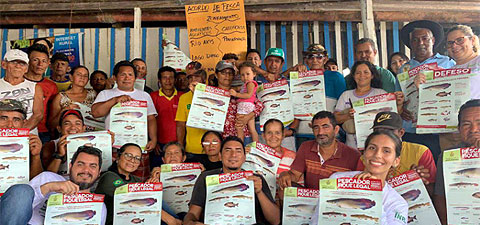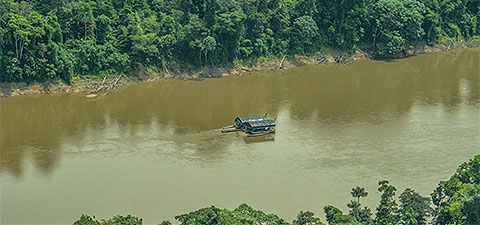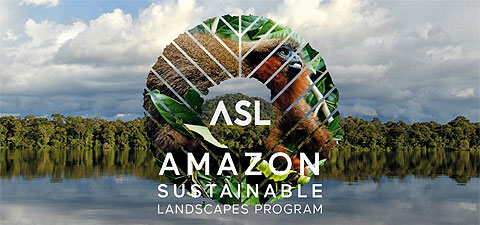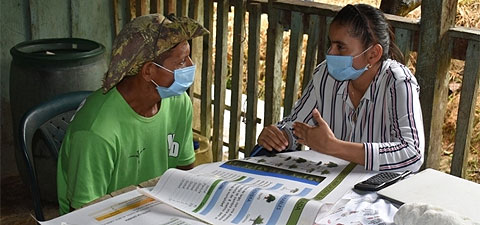
Connecting people and institutions to connect landscapes

The Amazon is the MOST BIODIVERSE PLACE ON EARTH, hosting 10% of the world´s known species.
In this webinar, we will explore how new technologies, including geospatial data, directly used by Indigenous Peoples can support effective management of their territories, providing them with accessible, up to date information to monitor threats and preserve their natural resources. Drawing on examples of participatory monitoring efforts from Brazil, Guyana, and Peru, speakers will show how new technologies, including mobile apps, drones, and satellite imagery, are being used to track areas of deforestation and provide compelling evidence to influence policymakers. Join us as we discuss how community-led initiatives supported by geospatial data can tackle environmental threats and support the protection of these invaluable territories.
Learn about the importance of the Amazon at local and global scales, the threats the region faces, and how sustainable development can help save its extraordinary biodiversity and peoples for current and future generations. This course is the product of a collaboration between the Science Panel for the Amazon (SPA), the World Wildlife Fund (WWF), and the World Bank (WB), with financial support from the Global Environment Facility (GEF). Available in English with transcripts in Spanish and Portuguese. Start date: March 18, 2024
This analysis provides important data on funding for conservation and sustainable development in the Amazon, especially given its focus on the period in which the COVID-19 pandemic occurred. This information can be used to inform and promote dialogue leading to enhanced donor coordination efforts. Key recommendations include updating these data regularly, enhancing the analysis with impact evaluations, using the data to establish synergies among donors and recipients, and increasing funding that goes directly to indigenous and local communities. The study makes the updated funding data from 2013-2022 available in an interactive open access data visualization dashboard, which was created by the World Bank during the previous study.

Illegal mining in the Amazon region affects ecosystems and their biodiversity and the health of local and Indigenous communities. These effects are exacerbated by the indiscriminate use of mercury, a toxic metal used to separate gold in the mining process. ...
Several examples of collaboration along issues that require critical attention are highlighted in this newsletter. Particularly, the partnership established between the ASL, Amazon Regional Alliance for the Reduction of the Impacts of Gold Mining (ARAIMO, its acronym in Spanish), and Conservation Strategy Fund (CSF), which has led to increased multi-country, multi-stakeholder dialogue on issues related to illegal mining and mercury contamination, as well as generation and dissemination of information for better decision making.
The ASL Regional Project commissioned Climate Focus to examine the social and economic impacts of the ASL1-supported restoration projects and provide recommendations for scaling up. The primary focus of the study was on employment opportunities resulting from forest restoration. The study analyzed the four ASL1 projects in Colombia, Peru, and Brazil, which involved various restoration activities and quantified direct and indirect employment generated by these activities.
This year, the International Day of the World's Indigenous Peoples recognizes the efforts of Indigenous Youth to support sustainable development, along with their pursuit of justice and preservation of their culture and traditions. The World Bank interviewed Indigenous Youth leaders around the world, including Eglenis Valerio of the Ticuna people and Danixa Moreno of the Nonuya people from the Amazon region. They highlighted the importance of strengthening and revitalizing their connection with the environment as key to their identity.
The guidance note illustrates the challenges, experiences and lessons learned across ASL and GWP projects on ecological corridors and connectivity. Sub-themes include spatial connectivity planning, governance, management and monitoring plans and public participation in connectivity.

In this newsletter we are happy to share the ASL third phase approval by the GEF council. Among other interesting stories and news, you will also read about the ASL Progress Report showcasing the accomplishments, challenges, and lessons learned from the AS1 and ASL2 projects during 2022 and the collaborative work with the Foundation for Conservation and Sustainable Development (FCDS) and Conservation Strategy Fund (CSF) on a set of activities aimed at strengthening regional collaboration to counteract, restore, and respond to the impacts of gold mining and pollution generated by mercury use in the Amazon region.
This report provides an overview of our program and showcases the accomplishments, challenges, and lessons from the ASL1 and ASL2 projects, all of which have been possible thanks to the successful collaboration with governments, project teams, civil society, donors, and other organizations working in the Amazon region. More information on the third phase (ASL3) of the program is also included.
The Amazon biome represents half of the planet´s remaining tropical forests, covering nearly 40% of South America, containing 20% of the global freshwater resources. It spans eight countries: Bolivia, Brazil, Colombia, Ecuador, Guyana, Peru, Suriname, and Venezuela, as well as French Guyana, a French overseas territory. The Amazon is the MOST BIODIVERSE PLACE ON EARTH hosting 10% of the world’s known species, including endemic and endangered ones, contributing to crucial ecosystem services at the local, regional, and global levels.
Join us in this technical learning event organized by the Biodiversity Conservation Technical Group of the World Bank, in collaboration with the World Wildlife Fund (WWF) and the ASL Program to learn about river dolphins and the perils that six species are facing to survive in the only two regions where they live (South America and South Asia). We will discuss the conservation and avoidance measures taken to reduce harm to these dolphin species as a result of development projects, including those in the World Bank.
In this newsletter we celebrate International Day of Forests by showcasing the story map “Forests and Health” where we highlight the importance of some medicinal and high-nutrient plants founded in the Amazon. You will also read about two remarkable Amazonian women and our national project team stories among other interesting news!
Wetlands are "areas of marsh, fen, peatland or water, whether natural or artificial, permanent or temporary, with water that is static or flowing, fresh, brackish or salt, including areas of marine water the depth of which at low tide does not exceeded 6 meters." Learn about the importance and characteristics of Amazon wetlands in this infographic.
In this newsletter, we highlight some of the most recent stories about activities carried out in collaboration with different organizations such as the Center for International Forestry Research (CIFOR), Wildlife Insights (WI), and other GEF-funded programs like the Global Wildlife Program (GWP), on issues of gender, wildlife monitoring, and corridors and connectivity. You will also read some stories from national project teams among other interesting news!
Women play an important role as agents of change within their communities, making valuable contributions to the protection and care of the environment. In order to analyze the gender gaps present in conservation and sustainable development initiatives in the Amazon region and identify solutions to address them, the Amazon Sustainable Landscapes regional Project produced the “Women's Solutions: Lessons for Conservation and Sustainable Development of the Amazon” study.

Camera traps and technology accessible to communities and governments can be powerful tools for conservation decision making. The ASL regional project partnered with Wildlife Insights (WI) to develop a dedicated data explorer tool that assesses and analyzes images of wildlife captured by camera traps.

The study highlights success stories in the Amazon regions of Brazil, Colombia, and Peru, where gender gaps have been reduced, and from which lessons and relevant recommendations for other interventions can be drawn. The study was commissioned by the regional project of the Amazon Sustainable Landscapes program and prepared by the Center for International Forestry Research (CIFOR).
The Amazon Sustainable Landscapes Program and the Global Wildlife Program (GWP) projects are promoting improvements in landscape connectivity. Starting in April 2022, the teams commissioned a series of workshops to promote the exchange of knowledge among their national projects and the use of the latest knowledge about connectivity and corridors.
The ASL is encouraging and incorporating efforts of youth across their programs through activities such as gardening, beekeeping, forest restoration, and environmental education. Youth and representatives from ASL teams recently shared activities and lessons learned to conserve the Amazon in a conversation hosted by the ASL.
The theme of this year’s International Day of the World’s Indigenous Peoples is The Role of Indigenous Women in the Preservation and Transmission of Traditional Knowledge, recognizing the role of indigenous women as the backbone of Indigenous Peoples’ communities and their crucial role in the preservation and transmission of traditional ancestral knowledge. Many indigenous women are also taking the lead in the defense of their territories and advocating for Indigenous Peoples’ collective rights worldwide.
In this newsletter we are excited to highlight the Amazon Sustainable Landscapes (ASL) 2021 Progress Report. During 2021, the ASL1 national projects achieved important results, showing strength and resilience in response to the challenges generated by the COVID-19 pandemic and making local and national level contributions to address the impacts of the global climate and biodiversity crises.
Community-Based Sustainable Tourism (CBST) is an emerging sector that offers travelers a more authentic and sustainable experience. It can add value to natural resource conservation and promote local livelihoods and jobs. The Amazon Sustainable Landscapes Program supports CBST, recently facilitating a knowledge exchange journey, including virtual lessons and a study tour with local entrepreneurs, community leaders, and government officials from Brazil, Colombia, and Peru.

The partner countries of the Sustainable Amazon Landscapes Program (ASL), Brazil, Bolivia, Colombia, Ecuador, Guyana, Peru and Suriname have gathered virtually once again in another successful ASL Annual Conference, which was held on November 17th and 18th 2021.

Read ASL’s latest newsletter with stories from our national projects, latest blogs and feature stories, such as The Amazon we want – and key ideas on how to get there, and publications from the ASL & partners.

The Amazon plays a critical role in influencing the global carbon cycle, it is the world’s largest freshwater system, hosting 40% of the world’s remaining rainforest and 10% of the world’s known biodiversity. Protecting the Amazon is a survival issue and a moral imperative that can be accomplished by promoting an integrated conservation and development model that is inclusive and socially, environmentally, and economically sustainable.

On Indigenous Peoples Day the Amazon Sustainable Landscapes Program recognizes the Indigenous people that coexist in balance with nature. Their culture & ancestral knowledge is essential for the conservation of the Amazonas.

Brave and committed Rangers risk their lives to protect and conserve the Amazonas. The Amazon Sustainable Landscapes Program recognizes their dedication and sacrifice while working on 210 protected areas.

The fisheries sector plays a significant role in the Amazonian local economy both for subsistence and livelihoods generation. Unsustainable commercial fishing and poor fishing practices threaten fish stocks and fish size. Five fisheries agreements with local communities in the Brazilian state of Amazonas will help promote sustainable fishing and establish regulations for sport and commercial fishing.

Illegal extraction of gold and other minerals affects one of the world’s most biodiverse areas as well as the livelihoods of millions of people.

Pandemics have arisen roughly every 20 years over the past century and a half. The Amazon has characteristics – high diversity of wildlife virus hosts and rising deforestation rates – which are common to hotspots for emerging diseases. Yet, currently the Amazon is still considered a low spillover area.

Read ASL’s latest newsletter with the ASL Progress Report, the Study on International Funding, new projects receiving GEF endorsement, and additional financing approved to Forest Conversation and Sustainability.
The report documents the results and progress achieved by the national and regional projects during 2020. This progress results from the strong collaboration among the national and subnational governments and executing agencies, GEF Implementing Agencies, and especially the effort put forth by the ASL teams, including the coordination team, country teams, and associated partners.

The Amazon forest is the largest tropical forest in the world! It represents 40% of the planet's remaining rainforest.

Our ASL Community of Practice is a place for practitioners to connect, share, and collaborate on various topics across the Amazon region.
This study provides a starting point for donors, countries, and civil society to understand the current funding scenario, begin critical conversations on how these investments can be enhanced, and explore how donors can work together to strengthen and coordinate their efforts.
Women are agents of change making valuable contributions to conserve world's natural resources. We celebrate the wisdom, knowledge and tenacity of women who take care and protect forests and water resources in the Amazon.
The webinar will present the results of the global and Amazon Basin assessments, opening a discussion of the global, regional, and national benefits of free flowing rivers, the environmental, social, and economic impacts of disrupting rivers’ connectivity, and recommendations for multisectoral planning and river protection approaches that align with development goals.

Get the latest newsletter of the Amazon Sustainable Landscapes Program with a recap of the ASL Annual Conference, a report of community engagement and conservation agreements in Colombia, and the handover of ASL’s program coordintation from Adriana Moreira to Ana María González Velosa.
Managing forests sustainably involves putting a system in place that is ecologically sound, economically viable and socially responsible. This is essential for the preservation of the Amazon's forests.

The Heart of the Amazon project, part of the ASL Program, is working to strengthen institutional and community forest governance, conserve forests and promote sustainable management in the Amazon.
The ASL Annual Report provides an overview of the program and its main accomplishments since it was launched and includes information from the national projects in Brazil, Colombia and Peru.
Deforestation and degradation of forests increase our exposure to animal pathogens and enables zoonotic spillovers. ASL spoke with Dr. Marcia Chame about zoonoses and solutions for the future.
An interview with with Martin von Hildebrand on how Indigenous Peoples’ knowledge contributes to biodiversity and enables the Amazon conservation.
Amazon expert and leading ecologist Thomas Lovejoy discusses threats to the Amazon, how best to manage them, and the importance of ASL Program.
The Amazon forest landscape does more than give vital resources to the 33 million people that live in it. It sequesters 70bn tons of carbon, benefiting everyone.
Led by the World Bank, the ASL aims to protect globally significant biodiversity and implement policies to foster sustainable land use and restoration of native vegetation cover.
